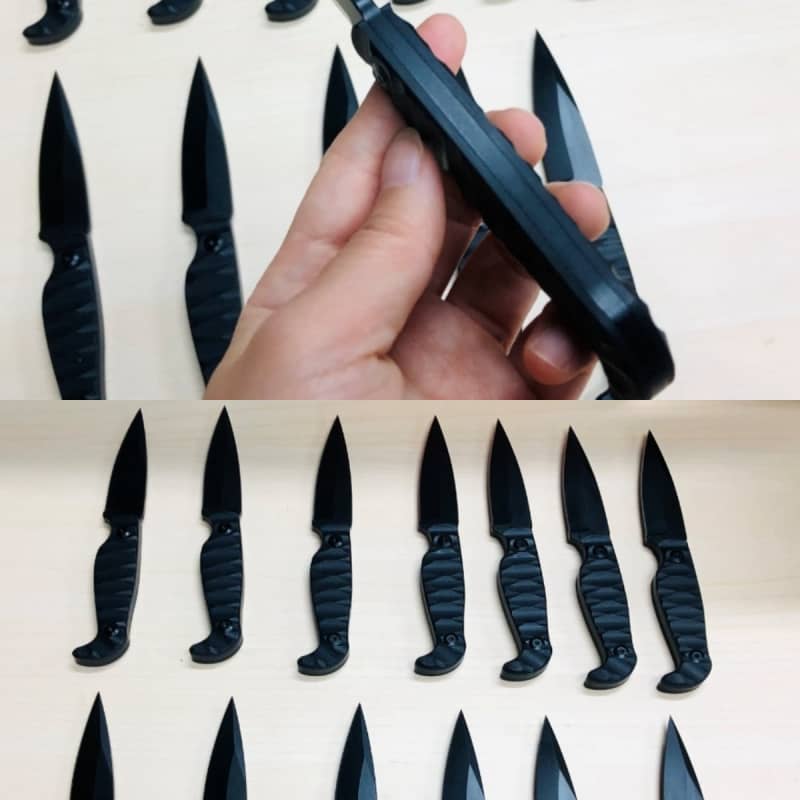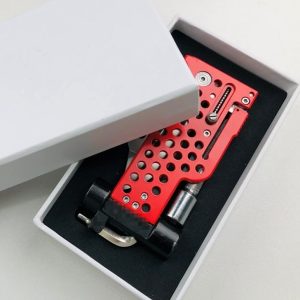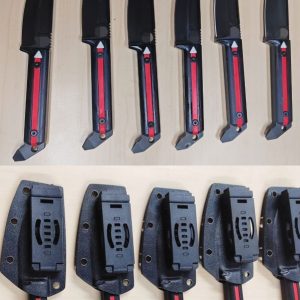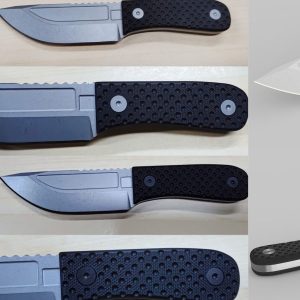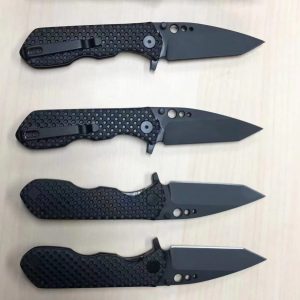Part 1 – Project Overview
Lead time
Shieldon has yet again proven its professionalism by producing living knives, training knives, and K-sheath, being packed together in a black plastic bag.
This project stretched over the course of six months, with one month allocated to drawing, another devoted to prototyping and readjustment, followed by two dedicated to production.
An additional month was scheduled for China’s Spring Festival.
Even though each stage posed its own unique set of issues and complications that needed solving, Shieldon’s experienced team knew how best to handle them in no time at all!
But what were these problems? How did they resolve them using knowledge within the OEM knives and tools industry?
Stay tuned to find out!
How the project came
A busy training center manager reached out to Shieldon for help with OEMing his 2020 training tool set.
With no time to produce or even design the product himself, he sought assistance from Shieldon’s team of experts.
Thus, the project began with a basic sketch created using an online program.
To learn more about this website’s URL and other details regarding its use, please don’t hesitate to reach out!
As many individuals are aware, starting a project with merely a sketch is challenging since the professionals have little to no idea of the customer’s wants.
The client was incredibly gracious and gave Shieldon an abundance of information while still allowing them the autonomy to explore and create.
As a result, the project came to a successful conclusion.
Shieldon’s team of experts not only saved the client money in free-trial website costs, but they also relieved his mind so that he could devote more time and energy to growing his own business.
Let Shieldon handle all OEM responsibilities, so you can focus on developing your business.
Products purchased
Item Name: Living Knife
Blade material: 154CM
Handle material: G10
Blade HRC: 58-60
Total length : 7.0″/ 177.3mm
Carry orientation: Both hands
Handle color: Black
Blade finish: Black titanium coating
Clip: in the K-sheath
Item Name: Training Knives
Blade material: Aluminum
Handle material: G10
Assembly hardware: T8 416SS
Carry orientation: Both hands
Handle color: Blue
Blade finish: Aluminum anodized
Clip: in the K-sheath
Item Name: Sheath
Material: Kydex
Eyelet: 2mm
Structure: folded
Clip: 304 stainless steel
Carry orientation: ambidextrous
Paring: 1 sheath for 2 knives (a living one and a training one)
Part 2 – Reasons why the customer chose us
Sketches and rendering of images
The project included the creation of two fixed knives, including live knives and training knives, as well as one K-sheath.
Before the production process, the CAD data must be verified.
The main aim of the design and manufacturing process was to achieve a handle scale that featured a concave convex texture, as this feature was both difficult to manufacture and an attractive selling point.
Supplied series number lasers
When customers are looking to use the limited edition of the toolset, Shieldon professionals must engrave the unique serial number on each knife.
To ensure confidentiality, Shieldon cannot showcase any names or total numbers associated with these knives – not even 001!
However, Shieldon experts have securely lasered a range of numbers from 001 to X00 at the backspace of all live blades.
K-sheath designing and production
After the two knives were forged, Shieldon had to craft a K-sheath that would snugly fit them.
To measure its inner size accurately, they needed an exact replica of the blades.
With just this idea and no guidance on how to execute it, Shieldon ingeniously designed a K-sheath that could accommodate both living and training knives – one sheath for two blades!
The result was remarkable; customers couldn’t help but be impressed with such creativity.
Packaging
After Shieldon consultants recommended a few affordable packaging solutions, the customer chose to go with black plastic bags that were printed with their company logo.
For a minimal cost, they had an eye-catching way of presenting their product.
Armed with two knives, Shieldon’s professionals packaged them in a simple case along with the K-sheath and sealed it securely in a black plastic pouch.
Even though the packing was rather straightforward, the Shieldon team verified that its durability would survive even demanding transportation conditions as aluminum is known for its softness and tendency to crack easily.
Shipment
Safely packed in boxes and sent on their merry way by air, Shieldon facilitated the customs clearance and logistics with such ease that all customers had to do was wait for their goods’ arrival.
Model creators and sellers have their expertise, yet lack knowledge of international trade. Many are concerned about how to import goods safely.
Shieldon has been tackling this problem for years; with their one-stop service, customers can rest easy knowing that we’ve got it covered!
Part 3 – Story of Manufacturing Process
This was the first draft that the buyer sent Shieldon, which was also a free trial on a website for knife creation, and his first knife design.
Nevertheless, Shieldon informed the client that they did not need to pay for the internet for additional sketching, since they could assist with all further steps.
Through dialogue, the customer informed Shieldon that they wanted their custom knife to exhibit features similar to those found on other models.
To illustrate this vision, he presented Shieldon with photographs of his preferred designs.
Just as the photo he displayed demonstrated, he sought a design featuring a straight clip point on its blade and no jumping.
Furthermore, there should be an optimal recess at the head of the handle G10 to enable it to snugly fit into its K-sheath.
In addition, he demonstrated to Shieldon how the handle would appear through two photographs.
He required the team to recreate the texture of the handle scale in the photograph.
The texture should be random, concave-convex, with sufficient depth to be readily grasped. And he also described the screws to the professionals.
Unfortunately, Shieldon believed that the screws in the picture did not match the handle well, therefore they suggested using a different kind of screws.
The client was confident in Shieldon due to their vast years of expertise with OEM and leaving the technical work up to professionals.
In addition, he was so preoccupied with corporate administration that he had little time to consider what would be best for the model.
Shieldon began creating rendering graphics of a live knife and a training knife for the buyer to see after having a quick notion.
He was satisfied with the job at this time. The living knife was a fixed-blade knife similar to the majority of blades on the market, but the training knife was unique.
It was shorter than the live version and had an overall blue color. It had no sharpened edge.
Made of aluminum, the training knife was lightweight and almost identical in form and feel as a besides.
Thus, the specialists had not encountered any issues up to this point, and they went on to measure the dimensions of the two models.
This was the structural picture created by Shieldon for OEM clients to review.
Each portion of the knife was marked with precise measurement symbols.
The indicators included blade length, blade thickness, blade belly width, handle length, handle width, handle thickness on texture top and texture bottom, logo placement length and thickness, and swedge width, among other measurements.
Shieldon made an effort to make sure that buyers understood the broad structure of the product prior to its release.
In order to provide clients with a clear mental picture, they often offer a structured image with precise measurement markers.
The living knife and the training knife are two different products, despite the fact that the majority of their dimensions are the same.
Nevertheless, there are a number of distinguishing characteristics.
In order to distinguish the variations, they created a new model of the training knife so that no one would be confused throughout the manufacturing process.
The blade tip is the primary distinction between the live knife and the training knife.
Since the training knife lacked a tip, Shieldon must create a rounded form to act as the tip, as they were unable to create a piercing tip.
To make it seem less menacing than a teaching knife toy, the specialists expanded the rounded tip as shown structurally.
Shieldon’s ability to think creatively led to the customer’s approval of the solution.
They all believe that the training knife is completely safe, therefore even children may use it.
In 25 days, prototypes were constructed for testing.
As said, Shieldon had superior screws to embellish the handle scales than what the client first displayed.
They used T8 screws fabricated from 416 stainless steel. It is sturdy, substantial, and challenging to remove.
Shieldon didn’t have any trouble with the functional prototypes of the live knives since they have been producing such fixed knives for years.
The issue was the training knife due to its physical nature.
Shieldon continued to discuss with the client the possibility that it would lengthen the manufacturing time and raise the scrap rate.
Shieldon has been staying in contact with clients through email and, if required, video chat in order to keep them informed of the experts’ progress in the workshop.
The buyer was shown 154CM steel as one of the recommendations for live knives by the specialists.
In the training, the knife might be used improperly, or the learner may lack familiarity with its appropriate usage, making it vulnerable to destruction or loss.
Because of these factors, Shieldon did not propose costly steel such as S35VN or M390. 154CM was the optimal option for his firm.
Meanwhile, metal was suggested for the training knives.
Experts advocate that aluminum is the preferred material for instructing young people in how to properly use a knife.
It has proven safer and more manageable than other types of steel when employed by adolescents or children in learning situations.
Because of the characteristics of aluminum steel, Shieldon’s training knife manufacturer encountered significant difficulties.
The difficulties stemmed from
- Because the hardness of the aluminum alloy material was low, the surface after polishing showed visible grinding marks, even when oxidized and colored.
- The spot where the knife landed was readily bent, as was typical of aluminum alloy, and could be altered.
The image clearly shows that the edge of the aluminum handle was rough, and the blade had several grinding marks.
Shieldon inquired as to whether additional steel materials needed replacement.
Following the oxidation process, the training knife had taken on a captivating blue color with some variation in shade – nearly identical to that of G10 blue scales.
Shieldon proposed making the edge of the training knives more rounded for safer use.
Illustrations were presented to showcase what this would look like on both sides of the knife: spine and edge.
Additionally, they worked hard to reduce any machine marks that might be visible on its exterior surface.
Returning to the living knives, the buyer inquired about the finest finish.
He distinguished between black titanium, nitrogen, DLC, PVD, and other finish coatings.
Shieldon suggested that his live knives be coated in black titanium, which would boost corrosion resistance while decreasing cost.
Black titanium coating is commonly utilized in a variety of items, including scissors, outdoor blades, and culinary knives.
Several of the Shieldon-branded knives have black titanium-coated blades.
Nitride coating is readily scraped off, and PVD gives the product a cheap appearance. This is too pricey for DLC and does not need to be coated in the 154CM blade.
Shieldon offers a unique service to customers: they provide personalized living knives, engraved with numbers in the series from 001 through X00.
Before laser-engraving begins, their team will consult with you to confirm the placement and font/size of letters for your custom piece.
After verifying the position and size of the lettering, Shieldon began experimenting with one-piece engraving and presented its work to the customer.
Upon approval from the said customer, they proceeded to laser etch for all remaining pieces.
Besides the live knives and training, this project also includes the design and construction of a Kydex sheath.
At the start, the client provided the Shieldon team with a few photographs of the form of the K-sheath and told me how the clip was attached.
For conformity, the K-sheath should have various angles and rounded edges on the bottom.
He would want to construct two sheaths, one for the live knife and one for the training knife, if feasible. He hopes the sheath may be put on both the left and right sides at the same time.
The team started to get a notion of how the Kydex sheath he desired, but this was just the first conversation.
Shieldon encourages its OEM customers to look outside the box and push boundaries, inspiring creative thinking and innovative product designs.
Shieldon first validated the specifics of the K-sheath, such as the color, the eyelet, the mouth size for inserting blades, the clip design, and so on.
This was just basic information since the team needed to utilize a real knife to build the molding sets of the sheath, ensuring that the knife matched the sheath properly.
Molding sets are created in 7 days, and mass manufacturing takes around 20 days.
Before making molding sets, the specialists created 6 sheath prototypes for testing and sending to the client for shape approval.
Shieldon obtained ordinary clips from outside to save time and money on the sheath clip. Of course, the clip form must correspond to the sheath they were creating.
It’s known as a cloth grabber clip. There are numerous sizes to choose from.
They determined the ideal size for the sheath that was going to be manufactured, but Shieldon also considered how comfortable it would be while worn on the belt.
Second, since the clip was threaded through the sheath for attaching, Shieldon was concerned that if the knife was placed within the sheath, the clip would scratch the knife surface.
The team adjusted the sheath somewhat to prevent the problem that they anticipated.
Since the clip size data is not disclosed, they designed different structures and compared which one was best to match the knife design in achieving the requirements.
In this case, the structural drawing was the most appropriate, and they finally settled on it.
You can see that 1 simple K-sheath, regardless of which knife you put in, may fit both in either orientation.
Shieldon required redesigning the handle and making the friction point deeper. The workshop assured them they could test it after a week of testing in the laboratory.
Shieldon believes that the most critical factor in creating a successful ambidextrous sheath is friction between the handle and the sheath.
Just enough friction exists to keep the knife from slipping out of the sheath during the forceful action.
They changed the G10 handle on all prototypes once the test was certified, and they were also given to the client for testing prototypes and K-sheath together.
They bought the normal clip for the ambidextrous sheath.
The clip was blackened 304 stainless steel. The rear clip was long enough to fit through the sheath body and had a hole to screw to it.
This clip was strong enough to clasp the belt and secure the sheath when carried outdoors, even with the knife in it.
Shieldon brought the training and living knife prototypes to the K-sheath workshop to discuss design changes.
The workshop suggested adjusting the middle sheath clip eyelet.
The workshop recommended a basic sheath design since it was not assured that the head groove on both sides of the sheath was symmetrically stuck on the knife handle when folded.
The bottom borders may be more rounded.
The ambidextrous design requires symmetrical edges for blade storage.
The training knife and living knife have asymmetrical handle shapes, making ambidextrous design challenging.
They symmetrically adjusted the knife handle scales to correct the ambidextrous sheath.
The machine struggled to insert the clip eyelet in the midst of the K-sheath, so the workshop gave up.
They installed the brass-colored eyelet using the equipment shown in the photo. They measure eyelets attentively.
The workshop processed the number of parts after multiple communications.
Almost all components are modified as part of an OEM project.
The living knives’ and training knives’ handle scales were altered.
The red arrow indicated the lone area that needed improvement. To ensure that it could adhere to the K-sheath correctly, they made that area deeper and symmetrical on both sides.
The training knives, together with their adjustments, put an end to prototyping. Following that, they began mass-producing both knives.
Both live knives and training knives may fit in the modified K-sheath prototypes.
The mouth was where the principal modification was made.
Shieldon examined and measured the mouth’s proportions to ensure that both blades could be securely inserted within without removing the clip.
The trial and prototype procedure seemed to have been completed successfully.
The team constructed the molding sets for the K-sheath manufacturing in accordance with the production stage.
The customer’s training company required live knives to be made of 154CM steel, while the training knives were made of 6061 ordinary aluminum, which is a standard alloy of aluminum for all-purpose applications.
Shieldon often produced 10% extra than what the client ordered since they anticipated that some products might be damaged in production.
But, the buyer requested 20 extra pieces for live knives throughout mass manufacturing.
They faced a new issue as a result of not having additional supplies ready.
The raw materials required to produce further hundreds of pieces would need to be purchased if they added 20 more manufacturing units.
Shieldon had to carefully plan its manufacturing and lower the percentage of damaged items in order to provide the entire quantity the client had requested.
In one month, the K-sheaths were completed, which was not difficult.
But, the raw materials they produced at the beginning were only enough for the order, therefore they didn’t have extra K-sheath for more orders.
Proactive planning of raw materials has always been a priority in production.
The manufacturing of training knives and live knives was virtually complete.
The training knives were made out successfully to match the blue G10.
The black G10 for the live knives was created while the living knives were shipped to black titanium finishing and would be done in two days.
Shieldon determined the weight and amount of the products and sent information to the logistics business for a balance quotation when the project was nearly complete.
Shieldon finished placing the engraving, and all training and live knives were laser-cut.
They applied antirust oil to the whole surface of all the blades for two to three days after the laser treatment was finished, shielding them against rust for years.
For further confirmation, they also supplied the buyer the photos of the logo.
The whole order of live knives was created and expertly inscribed with the logo and series number.
Shieldon shot several pictures for the client to see. He was eager to get the merchandise for sale.
The training knives’ whole order was created and expertly etched with the brand. The training knives had no series number.
Shieldon cleared and packaged as the final stage before shipment after the training, living, and K-sheath were all made out.
Shieldon bought the black bags, as the samples verified. The consumer saved money and weight because of the straightforward packing.
The bag’s dimensions were selected to accommodate a K-sheath, a training knife, and a piece of the live knife within.
The team devised a method of protecting the goods to prevent collision damage while in transit.
The black plastic bag isn’t too ornamented or crafty.
It’s merely a water-resistant bag with a silver inside and a black outside.
But, there is enough room for the things inside and it seals. When the products are placed in the bag, it arches up and doesn’t look good.
Shieldon requested the buyer to confirm this sort of bundle, but because he worked for a training company and had his own methods of selling, he wasn’t too concerned about the package.
In the last round of quality assurance testing, Shieldon discovered a problem with the black titanium coating on live knives.
Little flecks may be seen on the blade’s surface in the photograph.
This was due to the fact that if the coating environment was not completely clean, even a little amount of dirt may end up within the coating machine or adhere to the blade surface, in which case the coated substance would cover the dirt and adhere to it.
It may be removed with the coating substance by scraping it away, leaving a clear blemish on the blade surface.
They, in Shieldon’s opinion, needed to be recoated and were unqualified.
When they returned to work after the lengthy break, the remainder of the knives with this problem had been re-coated.
The project was then finished.
A fixed knife just requires a complete tang blade with scales on both sides joined by screws, unlike a folding knife, which also needs a functional pivot mechanism and manual deployment tension required.
Shieldon has a set process for quality assurance, which was a major consideration for this project.
The training knives must remove the grinding markings from all parts in addition to separating the coating problem pieces from the fully finished knives using the living knives.
They were guided in this phase by quality control to verify the problems with the items.
Shieldon put a training knife and a live knife in separate basic boxes with PP bags, K-sheaths, and bubble wrap.
Shieldon feared that when everything was wrapped in a black bag, the live knives might fall out—which, according to consumer feedback, they did.
The buyer also reported that 2 to 3 components had issues with screwing and machining on the handle.
Shieldon apologized for such trivial issues.
Nonetheless, the client understood that there would always be some issues during mass manufacturing, and these issues weren’t a huge concern.
He informed them that he had previously sold hundreds of pieces and that the products might be sold as well.
Part 4 – Shipping and Summary
Shieldon returned to work after their lengthy holiday and worked on the other blades that were experiencing problems.
Shieldon promptly prepared them for shipping to the purchaser.
This time, the customer requested not to engrave anything on the knives because he wanted to change the way he approached sales, which suited Shieldon’s needs.
Before packaging and shipping, the experts exhibited the finished parts in pictures and asked the buyer to check everything.
Shieldon gave the transported knives the same meticulous inspection they gave the live knives before shipment.
The consumer informed Shieldon that he had received favorable comments after selling hundreds of items in a single month.
Knives were often employed in his training facilities for tactical butterfly knife and Balisong knife maneuvers.
Training knives were excellent for becoming used to using a blade without danger.
Shieldon sent these pictures before his extended trip.
They took pictures and provided the buyer with all packing information to ensure that he understood how many articles Shieldon packed into each box.
Also, they employ a robust crate and adequate bubble wrap for protection to prevent damage during overseas shipping.
Prior to delivery, Shieldon thoroughly sealed the boxes.
The items need to be declared to customs in both countries, just as in an international shipment.
Shieldon provides a one-stop shop solution from manufacturing to distribution as a manufacturer and trade organization.
Customs clearance is not a concern for the consumer. The items will be delivered to the specified location.
After a long hiatus, Shieldon shipped this photograph to promote their repaired knives.
With only three parcels available for shipment, DHL Express was utilized as a costly yet effective alternative to international shipping – and the customer fully comprehended its necessity.
The remarkable quality of each knife sparked immense interest in pre-sale, leading to promising sales figures.
The Shieldon team also hopes OEM customers sell a lot and reorder from them.
Click on the customer’s website for more information:
https://www.evolutiontrainingsolutions.com/
Takeaways
The story of Shieldon’s Outstanding Training Knives Revolutionizing Weapon is a testament to the power of quality, innovation, and customer service.
By leveraging their expertise in manufacturing and trade solutions, they have created a product that has been met with great success.
As this case study demonstrates, paying attention to detail can make all the difference when it comes to creating products that customers love.
With these lessons learned from Shieldon’s training knife revolution in mind, businesses everywhere can strive for excellence in their own markets.
If you want more fun on Shieldon EDC, click their social media below:
Shieldon、Facebook、Instagram、YouTube、Twitter、Pinterest











































